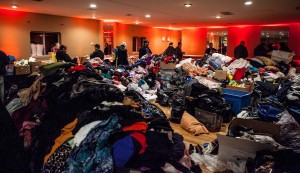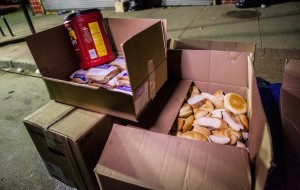Animal
November 5, 2012
Nearly a week after Sandy hit “landfall,” only pockets of Staten Island and Queens (mainly Rockaway) remain dark and devastated. But the situations on the ground between wounded areas in each borough starkly contrast each other. By yesterday, thousands of volunteers had descended on the now infamous wreckage along Staten Island’s New Dorp—and Midland—beach areas.
This massive contingent (including runners in Marathon gear) cleaned debris and brought in food and clothing by the ton. Bottled water is plentiful; stacks of different brands were piled along Cedar Grove Avenue along with unattended foodstuffs. Charities have set-up mini staging centers where they serve trays of piping hot food and offer access to generator power or even in one case, a TV to watch the football game.
Official looking convoys of rescue vehicles—manned exclusively by volunteers—roamed the neighborhood. Their speakers crackled: “We have hot food and blankets, do you need anything?” They waited for an answer then moved on. A catering hall on Ebbits Street and Roma Avenue, opened as a temporary relief center was stocked floor to ceiling with non-perishable groceries, donated clothing, and water. The woman who had commandeered the location the day before, 24-year-old Gina DeMatina stressed that despite her success in gathering donations, she wasn’t happy with the city’s recovery performance. “Where the hell is Bloomberg?” she wondered. “We haven’t seen him.”

(On Staten Island, food, clothes, toiletries, and other personal supplies were all bountiful.)
While for an election year, talk of national politics in this heavily Republican region is muted, everyone who I spoke to said they fully expected to be able to vote Tuesday. Historical party affiliations are still strong, but some minds have been altered by the recent conditions. John Avar, and two of his cousins, were picking through donated items on the steps of Our Lady of Lourdes, a small stucco church on Cedar Grove Ave. Each cousin said they had switched from Romney’s side to Obama for obvious reasons. “All Romney cares about the rich and obviously were not rich,” Avar explained.
Larger brightly lit city-sanctioned staging centers offered access to more hot food and clothing still. Seemingly missing in the mix was any sign of Red Cross or FEMA. Besides the federal agency’s shiny new RV, palettes of MRE’s, were the only visible evidence of the latter’s part in the relief effort. Michael Harwood, a 56-year-old volunteer, was serving hot food in one of the large staging centers on Father Capadano Boulevard, in Midland Beach. “I’ve been here since 3pm and I haven’t seen any FEMA people here,” he said. “[The relief effort] seems to be coming together without any top-down organization.”
At around 7pm, word from a National Guardsman was that FEMA, which had already shifted locations twice on Sunday, would be opening in a “wedding style tent” erected in the parking lot of New Dorp High School (also filled with donated clothing) at 8am. “I haven’t seen much of [FEMA],” said one particularly hard-hit resident, 50-year old Bruce Randall. “But I hear they’re mostly taking registrations.”
While cold and needy Staten Islanders eagerly picked through the bounty, by nightfall, a tremendous surplus of donated dry goods, clothing and water still remained untouched. These supplies were desperately needed a few miles away, in Rockaway, where there was no all-volunteer rescue effort was in place and FEMA’s presence was equally spectral. The beach has reclaimed some oceanfront blocks entirely, with dune like piles of sand running down them. One wonders how so much sand will ever be removed, never mind soon.
Unlike in Staten Island, there were no volunteers serving trays of hot food or untouched piles of MREs. Instead—near Beach 116 Street’s twisted boardwalk— a lonely generator lighting up a corner; underneath it a bag of ham and cheese sandwiches and some bread. A few people huddled here to stay warm, charge their cell phone and trade information about public transportation routes into the city, which shined brightly across the bay.
In the middle of the street, a married couple, Tommy and Angela Martinez, picked through a sad pile of leftover clothing, looking for some garments to keep them warm. The clothing had been dumped haphazardly on the strip’s median. Tommy, who lives a few blocks a way in a “wrecked basement,” said “shit got real hectic out here a couple of hours ago.” Residents had begun fighting amongst themselves for the scarce donated resources, resulting in injuries and arrests. His wife ticked off the problems community members faced in the blackout: no access to ATM’s or doctors, their car had been flooded out so getting around is difficult, and of course the constant lack of heat. The temperature was dipping and my teeth rattled as she started choking up. “I don’t know the next time I’m going to get a hot meal. Everything is closed!” she added.
A sense of panic about access to food is understandable because the only rumored “hot meals” on the peninsula are MREs at the FEMA center, which is located in a nearby desolate Waldbaum’s parking lot. When asked if I could sit down in FEMA’s one lit and heated tent, to get out of the cold, an agency worker barred entry. Their services are only available from 8am to 8pm, I was told, and the last bus had left an hour ago to “a city shelter.”

(Cold sandwiches and bread on Beach 116th Street.)
Since there was no free donated bottle water anywhere and the projects and high rises still lack water pressure, FEMA had allotted palettes of boxed tap water (unlike the MREs that were rumored to have been available earlier, this one key resource wasn’t locked up or otherwise missing in action). When the Martinezs’ were asked what they hoped for in the near future, they didn’t hesitate. “Power,” they said, in unison.
But just across the Marine Parkway Bridge, at Floyd Bennett Field, hundreds of vehicles—ambulances, humvees and trucks—were lined up in the night to report for volunteer rescue duty. From there they would be dispatched to their destination: hopefully it’s the Rockaways.